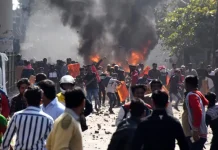There are fears of more clashes in and around Indian capital New Delhi as authorities enhanced police deployment and cut power and electricity supply to the protesting farmers camps. But hundreds more farmers arrived on tractors as reinforcement in the two-month long protest to force government to rescind three controversial farm laws enacted in September last year.
The farmers leaders signaled that they are ready for a “long war” as the government deployed thousands of extra paramilitaries around protesters camps.
After clashes on India’s Republic Day on January 26 across the capital city that left a man dead and nearly 400 police injured, authorities have started taking stringent steps to make life for campers difficult.
“When we don’t have any land left, when we are unable to cultivate any crops, we are going to die anyway,” said Bhagwant Singh, a 53-year-old farmer protesting outside the capital.
He said if they die while protesting against the government, they will be martyrs. “We will fight and die for the rights of the people of this country,” he added.
The authorities cut power and water to the Ghazipur camp on one main road into Delhi. Heavy police reinforcements were sent to the biggest camp at Singhu on another highway into the city and new concrete barriers were put up.
Police forcefully closed one small camp.
President Ram Nath Kovind told the opening of a budget session of parliament that the storming of the landmark Red Fort by protesters on Tuesday had been an “insult” to the national flag. The opposition parties boycotted the session in protest against government failure to resolve dispute.
The controversial reforms deregulate farm produce markets that have for decades been organised by state bodies with minimum prices guaranteed.
The farmers say the Hindu-nationalist government’s laws will put Indian conglomerates in control of produce.
Meanwhile, farmers have called off a plan to march on parliament on Monday when Prime Minister Narendra Modi’s government present annual budget, they reaffirmed their determination to stay at the camps.
Farmers leaders brought in generators to provide power, while the Delhi regional government, run by an opposition party, provided water tankers.
Some protesters left since Tuesday’s violence, but hundreds more men and women arrived during the night on tractors.









